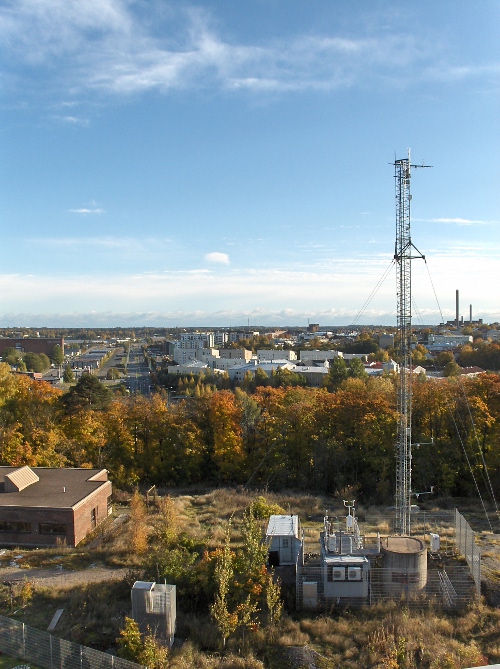Station for Measuring Ecosystem-Atmosphere Relations
The SMEAR III station started in Helsinki in autumn 2004. The idea was to expand the versatile atmospheric measurements to an urban area where the anthropogenic impacts are more evident. The instrumentation covers aerosol dynamics, atmospheric chemistry, micrometeorology, weather monitoring and ecophysiology of trees growing in the urban environment. The most characteristic features of the station are its location at high latitude and the vicinity of sea. The station is operated by the Departments of Physical Sciences, Chemistry and Forest Ecology (University of Helsinki), and the Finnish Meteorological Institute (FMI).

The station is currently situated in three different locations representing different urban surface types. The main site is located in Kumpula campus area about 4 kilometers north-east from Helsinki center. The measurement site is semi-urban and distinct surface cover areas (built, road and vegetation) in different wind directions can be observed. The micrometeorological measurements are made at a 31 meter high measurement tower (26 meters above sea level) located on a rocky hill. The measurements include radiation measurements and profiles of air temperature and wind as well as the vertical turbulent fluxes of momentum, heat, water, carbon dioxide (CO2) and total aerosol particle number using the eddy covariance technique on top of the tower. In addition, various measurement campaigns covering the fluxes of nitrous oxide and volatile organic compounds are made. Next to the tower is an air conditioned container where large diversity of aerosol particle and gas concentration instrumentation is located. These include size distributions, chemical composition and optical properties of aerosol particles. The SMEAR III station has also its own weather station and it is located in Kumpula on top of a University of Helsinki building at a height of 50 meters. In addition, the turbulent fluxes of momentum, heat, water, CO2 and aerosol particles are measured in Helsinki center on top of Hotel Torni. These measurements represent a highly built-up surface cover with a low fraction of vegetation.
The multidisciplinary ecosystem research lies in Viikki, 7 kilometers from Helsinki centre and 3 kilometers from the Kumpula site. Urban tree measurements cover transpiration measurements by chambers, stem diameters, soil temperature and humidity, photosynthetically active radiation and basic meteorological quantities.
The micrometeorological measurements are also part of the new Urban Boundary-Layer Atmosphere Network (UrBAN), which purpose is to uncover the urban boundary layer of Helsinki.
